ABSTRACT
We reviewed uptake of childhood immunization in Wales by quintile of deprivation and found that uptake was significantly lower in residents in the most socio-economically deprived areas compared with the least deprived. Differences were greater in older children. Services generally met best practice recommended by the National Institute for Health and Care Excellence; however, follow up of children who had not responded to invitations to attend routine immunization sessions needed more consistent implementation. Over a three year period to 2014–15 the difference in uptake between upper and lower quintiles at the fourth birthday reduced from 8.9% to 6.7%.
Reducing inequalities in health in Wales, including immunisation uptake, has been a strategic objective of the Welsh Government since at least 2011.Citation1,2 The National Institute for Health and Care Excellence (NICE) has reviewed the evidence for inequalities in immunisation uptake and published guidance on reducing differences in uptake in those aged under 19 y.Citation3 NICE identified 5 general areas for intervention: vaccination programmes, information systems, training, contribution of nurseries and education and targeting poorly reached groups, and identifying the characteristics of poorly reached groups including care status, history of illness, family characteristics and ethnicity.
In Wales, routine childhood immunisation services have been provided for over 20 y as a nationally contracted service through general medical practices using a national birth registration based call/recall system that generates named postal invitations sent to the home address, and maintains a clinical record of routine immunisations. Uptake of routine childhood vaccines has been high in Wales, with the exception of MMR vaccine from 1997–2009.Citation4 Government policy has required follow up of unimmunised children explicitly since 2005 for measles, mumps, rubella (MMR) vaccine at key ages: pre-school, in primary school and secondary school.Citation5 Under the ‘Flying Start’ program enhanced community public health nursing resources are directed to children aged under 4 y living in the most deprived areas, defined using the Welsh Index of Multiple Deprivation (WIMD) for lower super output areas (LSOA).Citation6 These services were initiated in 2007 and in 2012/13 were provided to 23,579 children, representing around a quarter of children aged under 4 in Wales.Citation7 Improving immunisation uptake by the fourth birthday is a key outcome indicator for that program.
This paper reviews the evidence for inequalities in uptake by socio-economic group in Wales, and presents preliminary data on the population impact of services since 2011 aiming to reduce those differences. Data were obtained from the National Community Child Health Database (NCCHD) sourced from Community Child Health databases in health boards, based on regular returns from service providers.
Data from 2011 showed that immunisation uptake generally decreased as age increased. There were also significant inequalities in immunisation uptake between children resident in the least deprived and most deprived LSOAs, at the first, second, fifth and sixteenth birthdays ().
Figure 1. The proportion of children that have completed all recommended routine immunisations by 1 y of age resident in the most deprived compared to the least deprived areas, Wales 2011. *Statistically significant difference between quintiles(p < 0.05).
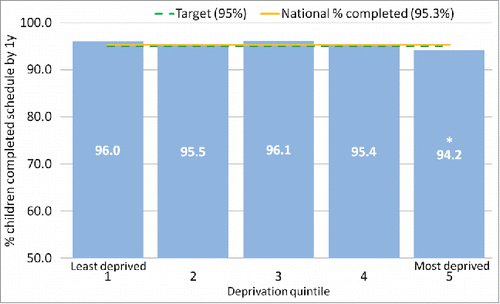
Figure 2. The proportion of children that have completed all recommended routine immunisations by 2 y of age resident in the most deprived compared to the least deprived areas, Wales 2011. *Statistically significant difference between quintiles (p < 0.05).

Figure 3. The proportion of children that have completed all recommended routine immunisations by 5 y of age resident in the most deprived compared to the least deprived areas, Wales 2011, *Statistically significant difference between quintiles (p < 0.05).
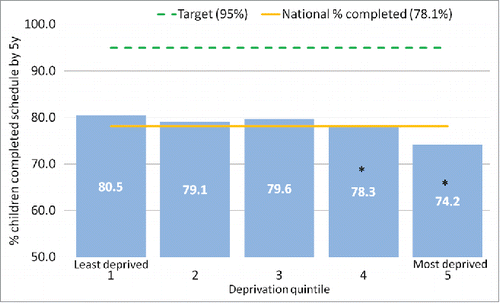
Figure 4. Proportion of children that have completed MMR and Td/IPV routine immunisations by 16 y of age resident in the most deprived compared to the least deprived areas, Wales 2011, *Statistically significant difference between quintiles for the same vaccine (p < 0.05).
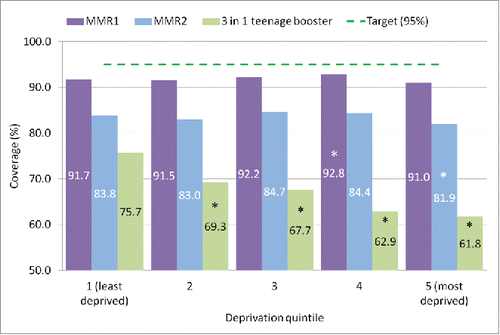
In addition, differences in immunisation uptake between children resident in the most and least deprived areas increase with age (). Similar findings have previously been reported for human papillomavirus (HPV) vaccine uptake in 14-year-old girls in Wales.Citation8
Figure 5. Difference in the proportion of children up to date with all vaccines (1, 2 and 5 years) and Td/IPV vaccine (16 years) resident in the most and least deprived areas, Wales 2011.
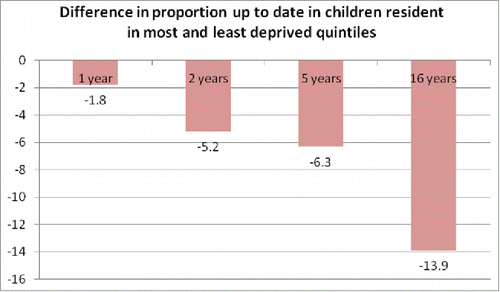
Over the 3 y from 2012–2015 uptake was higher in the least deprived areas and the difference in uptake of routine immunisations, by the fourth birthday, between children living in the most and least deprived areas of Wales changed from 8.9% (2012–13) to 5.2% (2013–14) to 6.7% (2014–15) ().
Figure 6. Change in the difference in uptake at the fourth birthday between children living in the most and least deprived areas between 2012–13 and 2014–15, Wales.
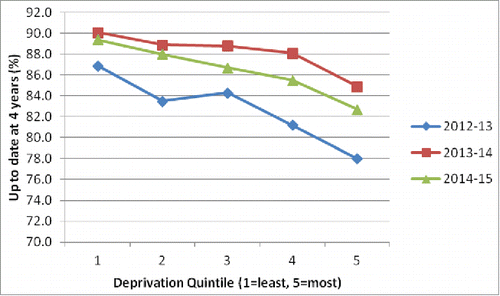
Local immunisation services were reviewed against the NICE criteria in 2015 and found to follow the majority of the recommendations for routine delivery of services. For example, follow up of identifiable groups, such as children in the care of local authorities and traveling families is addressed routinely. Areas needing further attention are the follow up of children who have not responded to initial and follow up invitations to attend General Practice premises at scheduled ages. Pre-school follow up is the responsibility of the health visiting services, and this transfers to school nurses from 4 y of age.
We found that the uptake of routine childhood immunisations was significantly lower in children resident in the most socio-economically deprived areas compared with the least deprived, and that the differences increased with age. Service review showed services generally met best practice recommended by NICE for reducing difference in uptake, but follow up of children who have not responded to invitations to attend General Practice needed more consistent implementation. Encouragingly, over the 3 y to 2014–15 the difference in uptake at the fourth birthday between most and least deprived areas reduced from 8.9% to 6.7%.
Evidence reviewed by NICE suggested a lack of data on the impact of universal interventions increasing uptake in poorly reached groups, but that targeted approaches could be effective.Citation3 Randomized controlled trials (RCTs) conducted in the UK and the USA found that multi-component community based interventions targeting children already behind on their immunisations increased the number of children who were up to date. Interventions varied between studies and comprised: home visits, advice and support for parents, local media campaigns, networking with local organisations, referral, reminders and immunisation in alternative settings such as hospitals.Citation9-11
A trial in Australia found that a domiciliary vaccination service for children who were behind on recommended immunisation schedule (DTP/IPV/Hib, MMR) significantly improved vaccination coverage compared with children who did not receive a home based vaccination service.Citation12 A domiciliary immunization service in England increased uptake of MMR vaccine at 2 y of age from 89% in 2007/08 to 96.9% in 2015.Citation13 Two RCTs of stepped interventions in the USA using initial postal reminders, phone calls and finally home visiting for those not attending for immunisation found positive effects in infants and adolescents.Citation14,15 Three observational studies from the UK and Canada comparing outcomes in control areas with those implementing combinations of postal or phone reminders with home visiting found improved immunisation uptake.Citation16-18
Wales has well developed services to deliver the childhood immunisation program, utilizing birth registers and a universal call/recall system which identifies and allows follow up of unimmunised children. The system achieves a high uptake for those who respond to invitations and attend their local general medical practice premises. Additional resources have been targeted through the Flying Start initiative at children living in the most deprived communities, which would allow enhanced follow up of children missing immunisations. Although inequalities still persist, we found evidence that national differences in uptake between the most and least deprived has narrowed since the introduction of this service, although official data show similar improvement in areas receiving usual care.Citation4,19 Further work is required to determine whether this effect is greater in those area receiving enhanced services, or applies in all areas as a result of other general improvements in the service.
Disclosure of potential conflicts of interest
No potential conflicts of interest were disclosed.
Acknowledgments
The authors wish to acknowledge the contribution of all health professionals, local child health staff and professional in Wales who contribute to and centrally maintain the National Community Child Health Database whose work has made this data analysis possible.
References
- Welsh Government. Fairer health outcomes for all. Reducing inequities in health strategic action plan. Cardiff: Welsh Government 2011. Available at: http://wales.gov.uk/topics/health/publications/health/reports/fairer/?lang=en (Last accessed 15/05/2016).
- Welsh Government. Together for Health. Cardiff: Welsh Government 2012. Available at http://www.wales.nhs.uk/sitesplus/documents/829/togetherforhealth.pdf (Last accessed 15/05/2016).
- National Institute for Health and Care Excellence. Immunisations: reducing differences in uptake in under 19s. London: NICE 2009. Available at https://www.nice.org.uk/guidance/ph21 (Last accessed 15/05/2016).
- Public Health Wales. Vaccine uptake in Children in Wales, 2014–15. Cardiff: Public Health Wales 2015.
- Welsh Assembly Government. MMR catch up immunisation programme (WHC 2005 081). WG 2005. Available at http://www.wales.nhs.uk/documents/WHC_2005_081.pdf (Last accessed 15/05/2016).
- Welsh Government. Flying Start Strategic Guidance. Cardiff: Welsh Government 2012. Available at http://gov.wales/docs/dhss/publications/120913fsguidanceen.pdf (Last accessed 15/05/2016).
- National Assembly for Wales. Flying Start Research Note. Cardiff: National Assembly for Wales 2014. Available at http://www.assembly.wales/research%20documents/flying%20start%20-%20research%20note-03032014-254185/rn14-005-english.pdf (Last accessed 15/05/2016).
- Simon C, Thomas DR, Roberts RJ. 2012. Inequalities in uptake of vaccination against Human Papillomavirus (HPV) in Wales. European Scientific Conference on Applied Infectious Disease Epidemiology, Edinburgh 2012. In ECDC: ESCAIDE 2012 Abstract Book, pp84. Available fromhttp://ecdc.europa.eu/en/ESCAIDE/Materials/Documents/ESCAIDE-2012-abstract-book.pdf
- Johnson Z, Howell F, Molloy B. Community mothers' programme: randomized controlled trial of non-professional intervention in parenting. BMJ 1993; 306(6890):1449–52; PMID:8518642; http://dx.doi.org/10.1136/bmj.306.6890.1449
- Johnston BD, Huebner CE, Anderson ML, Tyll LT, Thompson RS. Healthy steps in an integrated delivery system: child and parent outcomes at 30 months. Arch Pediatr Adolesc Med 2006; 160(8):793–800; PMID:16894077; http://dx.doi.org/10.1001/archpedi.160.8.793
- Wood D, Halfon N, Donald-Sherbourne C, Mazel RM, Schuster M, Hamlin JS, Pereyra M, Camp P, Grabowsky M, Duan N.. Increasing immunization rates among inner-city, African American children: A randomized trial of case management. JAMA 1998; 279(1):29–34; PMID:9424040; http://dx.doi.org/10.1001/jama.279.1.29
- Bond LM, Nolan TM, Lester RA. Home vaccination for children behind in their immunisation schedule: A randomised controlled trial. Med J Aust. 1998; 168:487–90; PMID:9631672
- MacDonald P. Ensuring excellence in immunization services. Hum Vaccin Immunother 2016; 12(1):252–4; PMID:26618244; http://dx.doi.org/10.1080/21645515.2015.1093262
- Hambidge SJ, Phibbs SL, Chandramouli V, Fairclough D, Steiner JF. A Stepped Intervention Increases Well-Child Care and Immunization Rates in a Disadvantaged Population. Pediatrics 2009; 124:455–64; PMID:19651574; http://dx.doi.org/10.1542/peds.2008-0446
- Szilagyi PG, Humiston SG, Gallivan S, Albertin C, Sandler M, Blumkin A. Effectiveness of a Citywide Patient Immunization Navigator Program on Improving Adolescent Immunizations and Preventive Care Visit Rates. Arch Pediatr Adolesc Med 2011; 165:547–53; PMID:21646588; http://dx.doi.org/10.1001/archpediatrics.2011.73
- Atchison C, Zvoc M, Balakrishnan R. The Evaluation of a Standardized Call/Recall System for Childhood Immunizations in Wandsworth, England. J Community Health 2013; 38:581–7; PMID:23355104; http://dx.doi.org/10.1007/s10900-013-9654-4
- Isaac MR, Chartier M, Brownell M, Chateau D, Nickel NC, Martens P, Katz A, Sarkar J, Hu M, Burland E, et al. Can opportunities be enhanced for vaccinating children in home visiting programs? A population-based cohort study. BMC Pub Health 2015; 15:620. Available at http://bmcpublichealth.biomedcentral.com/articles/10.1186/s12889-015-1926-8 (Last accessed 23/05/2016); http://dx.doi.org/10.1186/s12889-015-1926-8
- Lemstra M, Rajakumar D, Thompson A, Moraros J. The effectiveness of telephone reminders and home visits to improve measles, mumps and rubella immunization coverage rates in children. Paediatr Child Health 2011; 16:e1-e5; PMID:22211079
- Welsh Government. Flying Start summary statistics 2014–15. Cardiff: WG 2015. Available at http://gov.wales/docs/statistics/2015/150714-flying-start-summary-statistics-2014-15-en.pdf (Last accessed 15/05/2016).
